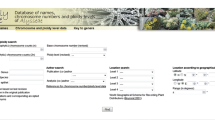Abstract
A taxonomic reevaluation of two little-knownBrimeura taxa,B. fontqueri (Pau)Speta andB. duvigneaudii (L. Llorens)Rosselló et al., has been made.Brimeura fontqueri, described from the Iberian peninsula, has been put into synonymy ofB. amethystina (L.)Salisb., since it could not be distinguished on morphological, anatomical or cytogenetic grounds.Brimeura duvigneaudii, from the Balearic Islands, is closely related toB. amethystina and has 2n=28 chromosomes. It differs from the latter by its naked bulbs lacking dark cataphylls, and its narrower leaves and whitish corollas. Accessory chromosomes are reported for the first time in the genus. Karyological instability (with chromosome numbers ranging from 2n=28 to 42) is reported for a population ofB. fastigiata (Viv.)Chouard. A key to the recognized taxa ofBrimeura is provided.
Similar content being viewed by others
References
Almeida da Silva R.M. (1998):A taxonomic revision of some European Hyacinthaceae:the Scilla vernacomplex and BrimeuraSalisb. Ph.D. Thesis, University of Porto, Porto.
Almeida da Silva R.M. &Rosselló J.A. (1999): Anatomical studies on theScilla verna (Hyacinthaceae) complex.Israel J. Pl. Sci. 47: 103–110.
Alomar G., Mus M. & Rosselló J.A. (1997):Flora endémica de Balears. Consell Insular de Mallorca, Palma de Mallorca.
Bibiloni G., Llorens L. &Rita J. (1989): El géneroBrimeura Salisb. en las islas Baleares.Acta Bot. Malacitana 12: 151–160.
Cadevall J. (1933):Flora de Catalunya (Flora of Catalonia) 5. Institut d’Estudis Catalans, Barcelona.
Chouard P. (1930a): Révision de quelques genres et sous-genres de Liliacées bulbeuses d’après le développment de l’appareil végétatif (Scilla, Endymion, Hyacinthus).Bull. Mus. Hist. Nat. (Paris), 2 sér., 2: 698–706.
Chouard P. (1930b): Régéneration des bulbilles sur les feuilles vertes de certaines Liliacées.Compt. Rend. Hebd. Seances Acad. Sci. (Paris) 191: 1146–1148.
Chouard P. (1931a): Révision de quelques genres et sous-genres de Liliacées bulbeuses d’après le développment de l’appareil végétatif (Scilla, Endymion, Hyacinthus).Bull. Mus. Hist. Nat. (Paris), 2 sér., 3: 176–180.
Chouard P. (1931b): Types de développement de l’appareil végétatif chez les Scillées.Ann. Sci. Nat., Bot., 10 sér., 13: 131–323.
Clowes F.A.L. (1961):Apical meristems. Blackwell Scientific Publications, Oxford.
Contandriopoulos J. (1962): Recherches sur la flore endémique de la Corse et sur ses origines.Ann. Fac. Sci. Marseille 32: 1–354.
Contandriopoulos J. (1964): Recherches sur la flore endémique de la Corse.Rev. Gén. Bot. 845: 361–384.
D’Amato F. (1978): Chromosome number variation in cultured cells and regenerated plants. In:Thorpe A. (ed.),Frontiers of plant tissue culture 1978, Proceedings of the 4th International Congress of Plant Cell and Tissue Culture, International Association for Plant Tissue Culture, Alberta, pp. 287–295.
Damboldt J. &Melzheimer V. (1976):Brimeura fastigiata (Viv.) Chouard (Liliaceae) neu für die Flora Griechenlands.Bot. Jahrb. Syst. 95: 334–338.
Fernández Casas J., Molero J. &Pujadas J. (1980): Números cromosomáticos de plantas occidentales, 35–37.Anales Jard. Bot. Madrid 36: 391–393.
Font Quer P. (1915): Una excursió a la Catalunya transiberica (An excursion to transiberian Catalonia).Treb. Inst. Catalana Hist. Nat. 1: 9–35.
Font Quer P. (1947): Acerca de algunas plantas raras, críticas o nuevas (About some rare, critical or new plants).Collect. Bot. (Barcelona) 1: 261–314.
Garbari F. (1966): Alcune osservazioni sul genereBrimeura Salisb. (Some observations about the genusBrimeura Salisb.).Giorn. Bot. Ital. 75: 324–325.
Garbari F. (1968): Iconografia cromosomica di alcuneLiliaceae.Atti Soc. Tosc. Sci. Nat., Mem. ser. B, 75: 163–178.
Garbari F. (1970): Il genereBrimeura Salisb. (Liliaceae) (The genusBrimeura Salisb. (Liliaceae)).Atti Soc. Tosc. Sci. Nat., Mem. ser. B, 77: 12–36.
Garbari F. (1981): Il cariotipo-typus, nuovo concetto della citosistematica (The karyotype-type, a new cytotaxonomic concept).Stud. Tren. Sci. Nat. 58: 255–264.
Holmgren P.K., Holmgren N.H. &L.C. Barnett L.C. (1990): Index Herbariorum. Part I: The herbaria of the world. Ed. 8.Regnum Veg. 120: 1–163.
Hu Han H.T.Y., Tseng C.C., Ouyang T.W. &Shing C.K. (1978): Application of anther culture to crop plants. In:Thorpe T.A. (ed.),Frontiers of plant tissue culture, International Association for Plant Tissue Culture, Calgary, pp. 123–130.
Levan A., Fredga K. &Sandberg A.A. (1964): Nomenclature for centromeric position on chromosomes.Hereditas 52: 201–220.
Llorens L. (1984): Notas florísticas baleáricas.Folia Bot. Misc. 4: 55–58.
Molero J. (1975): Notas taxonómicas y fitogeográficas.Anales Inst. Bot. Cavanilles 32: 349–361.
Reichenbach H.G.L. (1830):Flora Germanica excursoria 1. Carolum Cnobloch, Leipzig.
Rosselló J.A., Mus M. &Mayol M. (1992): Una combinación nueva enBrimeura (Hyacinthaceae): B. duvigneaudii (L. Llorens) stat. nov.Anales Jard. Bot. Madrid 49: 293–294.
Salisbury R.A. (1866):The genera of plants. John Van Voorst, London.
Speta F. (1979): Karyological investigations inScilla in regard to their importance for taxonomy.Webbia 34: 419–431.
Speta F. (1982): Über die Abgrenzung und Gliederung der GattungMuscari, und über ihre Beziehungen zu anderen Vertretern der Hyacinthaceae.Bot. Jahrb. Syst. 103: 247–291.
Speta F. (1987): Die verwandtschaftlichen Beziehungen vonBrimeura Salisb.: ein Vergleich mit den GattungenOncostema Rafin.,Hyacinthoides Medic. undCamassia Lindl. (Hyacinthaceae).Phyton (Horn) 26: 274–310.
Vosa C.G. (1979): Heterochromatic banding patterns in the chromosomes ofBrimeura (Liliaceae).Pl. Syst. Evol. 132: 141–148.
Author information
Authors and Affiliations
Corresponding authors
Rights and permissions
About this article
Cite this article
Almeida da Silva, R.M., Sáez, L. & Rosselló, J.A. Taxonomy of the genusBrimeura (Hyacinthaceae). Folia Geobot 36, 193–208 (2001). https://doi.org/10.1007/BF02803161
Received:
Revised:
Accepted:
Issue Date:
DOI: https://doi.org/10.1007/BF02803161




